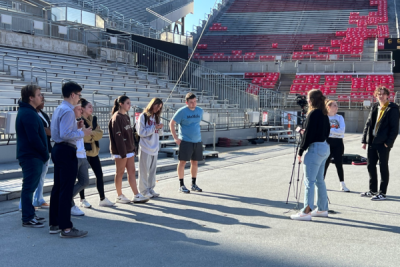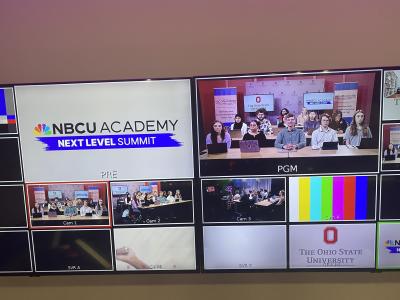From writing their first stories in the award-winning student publication The Lantern to getting published in real-world news outlets, undergraduate journalism students at Ohio State can participate in professional development opportunities and hands-on training that spans a wide range of news media.

By the time they graduate, students have created news and feature content for all media types, including digital, print, photo and video. Recent Ohio State graduates are now working for media outlets such as Bloomberg News, The Washington Post, CBS News and CNBC.
Learning the craft in the newsroom and the classroom
Alumni who visit campus will see much that’s familiar about the journalism program, but other areas have evolved with the changing media landscape. Notably, The Lantern, advised by Director of Student Media Spencer Hunt, remains an independent source of news and feature content about the university community.
In a significant 2023 milestone, The Lantern successfully filed a lawsuit against the university for its refusal to provide public records related to former university president Kristina Johnson's departure. It was the paper’s second successful suit over the university regarding public records. This legal victory stands as a testament to The Lantern’s independence from the university and the program's commitment to upholding the principles of independent journalism, empowering students to make a meaningful impact in the field.

While the long-held commitment to independent reporting remains, The Lantern looks different in many ways from the newspaper it once was. Today it acts as a 24/7 digital news organization with the tight and frequent deadlines that come with a nonstop news cycle. In addition to publishing a weekly print edition of the paper, The Lantern publishes daily content in the form of videos, podcasts, photojournalism, online articles and multimedia reports. Social media staff also help these stories find their way to readers on a daily basis.
“What we try to make sure is that our students are prepared for any journalistic career opportunity, from a skill development standpoint,” said Nicole Kraft, associate professor of practice and director of the Sports and Society Initiative. “They are treated as professionals from the start and they have professional-level experiences and pressure, professional-level expectations of themselves, because we really need them to recognize that if you're going to do journalism, you need to take it seriously.”
Ohio State’s program seamlessly integrates The Lantern into the journalism curriculum, which is a differentiating aspect of the program.
“It shows you that you need to get good grades, but then, you also need to be able to show people stuff that you did to help compete for those internships,” Hunt said. “If you have things published, that's really important and what people are looking for when they're making their intern hiring decisions.”
Journalism students are required to take Media Writing and Editing (COMM 2221), a course that gives prospective journalists their first taste of the industry and leaves many with their first published stories.
From there, students enter into Lantern Practicum (COMM 2223) where they are each assigned topics–or beats–to cover for The Lantern. Each student produces at least 14 articles for The Lantern by the end of the semester.
During their time in the journalism major, students will learn multimedia skills in Multimedia Journalism (COMM 3226) and engage with the legal and ethical implications of journalism in Media Law and Ethics (COMM 3404).
Finally, the capstone course that all Ohio State journalism students take is Data Journalism in Enterprise Reporting (COMM 4221), where they work on complex stories arising from systematic data of some kind, often obtained from state, university or other government sources. Stories from previous semesters have focused on women earning more degrees than men at Ohio State and the decline of standardized testing in college admissions.
“The Lantern has allowed me to understand the newsroom environment, mirroring the workplace, while also allowing me to make connections with fellow talented journalists,” Arianna Smith, editor-in-chief of The Lantern, said. “I have learned so much from my staff and this newspaper as they have both made me a better leader, student and overall person.”

New for 2024 is the return of Feature Writing (COMM 4202), formerly known as Magazine Writing. While other courses are geared toward students producing deadline-focused content consistent with that of a daily news enterprise, Feature Writing allows students to expand upon their skills by allowing for immersive, anecdotal and narrative writing, occasionally including the use of a first-person perspective. With these skills, students are able to produce bigger and more experimental pieces, such as Q&As and long-form features.
“What we're looking for now is people who can take more time with stories and really start to expand their use of language – the way that they craft, the amount of time that they spend doing interviews – and to put all of the skills that they've learned together and just elevate them to the next level,” Kraft said.
The course will also teach students how to pitch stories and approach publications with their articles in hopes that students are able to get published in the real world.
“There are a lot of different opportunities for students that will allow them to take the skills that they have, and amp them up in a way that will be beneficial to them while they're here, but even more beneficial when they leave,” Kraft said. “We want them to be able to make money as writers, if they wish to, and this gets them one step closer to being able to do that.”
The new Lantern newsroom
During the 2024-2025 academic year, The Lantern will make a historic move to a new and larger physical space on the first floor of the Journalism Building. Hunt said the move will more than double the size of the current newsroom.

The space will include a video studio exclusively for The Lantern’s use, with highly mobile equipment, as well as a larger TV studio and computer editing lab that will support basic video production classes in the Media Production and Analysis minor. Additionally, there will be expanded room for podcasting spaces, meeting rooms and a much larger newsroom.
“It's going to make The Lantern a lot more visible,” Hunt said. “I think it's a great commitment that the school is putting towards, you know, kind of really raising the image of The Lantern and the program here. So I'm really grateful for that.”
Undergraduate Journalism Program Director Gerald Kosicki said the space is intended to significantly boost The Lantern’s multimedia efforts as well as build new opportunities to collaborate with other students outside of the journalism program.
The last update to The Lantern space occurred during the mid-2000s when the School of Communication invested in audio, multimedia and related technologies. At that time, Buckeye TV was rebranded as Lantern TV (LTV) and integrated into the Lantern Media Group. Half of the space previously used for print media was designated for multimedia spaces and equipment, limiting the size of the actual newsroom.
“Adapting our range of products does require some additional space and tech, so we are grateful for the investments the college and school are making with the generous assistance of our alumni,” Kosicki said.
Direct connections to internships and entry-level positions
Journalism students are required to complete 150 hours, or three credit hours, of internship work to fulfill graduation requirements.

One new way students can seek out these opportunities is through the School of Communication’s partnership with NBCU Academy. Created by NBC Universal, NBCU Academy offers exclusive internship opportunities for its member schools, both in-person and online. Students have access to on-campus speakers and events through the partnership as well.
The School of Communication also provides many other opportunities for students to connect with potential employers. This fall, recruiters from TENGA, the media broadcasting group, visited multiple classes on campus and conducted on-site interviews with students for internships and employment.
Additionally, many alumni have generously dedicated their time to help mentor students looking for additional assistance in their career development. Specifically, each year Jay Smith mentors the editor-in-chief of the Lantern and Stephen Ohlemacher mentors the managing editor for digital content of the Lantern. Jocelyn Dorsey has also mentored in the past.
Scarlet and Gray Sports Radio, Big Ten+, Associated Press Sports Editors
Beyond the classroom and The Lantern, journalism students interested in the sports industry can foster reporting skills through Scarlet and Gray Sports Radio, Big Ten+ and the Associated Press Sports Editors student club.
Scarlet and Gray Sports Radio is the official student broadcast station for Ohio State Athletics and offers consistent coverage for 19 Ohio State sports, as well as eight weekly podcasts. The organization trains anyone who wants to be involved in sports broadcasting in color commentating, play-by-play reporting and sideline reporting.
“Scarlet and Gray Sports Radio has provided me the chance to broadcast over 13 different sports at Ohio State, learning how to call different sports and do as many as possible,” third-year journalism student and Scarlet and Gray Sports Radio Vice President Tyler Danburg said. As students’ skills develop, they are also given the opportunity to work for Big Ten+, the Big Ten network's student arm.
“The chance to cover all these athletic broadcasts is so crucial to professional development as a broadcaster because we get to learn the craft of radio broadcasting on SGSR and TV broadcasting on Big Ten Plus by calling games at the highest level,” Danburg said. “It is usually a different sport each day, and sometimes it is Scarlet and Gray Sports Radio one day and Big Ten Plus the next. We get a simulation of what professional life is like while in college, which is a unique experience that I have been fortunate to have for three years now.”
Ohio State students now also have the opportunity to join the newly established chapter of the Associated Press Sports Editors at Ohio State. This is one of the most prominent and prestigious sports media organizations in the country. The organization aims to provide training and networking and mentorship opportunities with media professionals and will start programming in January.
Alumni donations, mentoring and support are what help the journalism program expand for future generations of students. See opportunities to give back to the School of Communication.
Article by student Jessica Barboza
